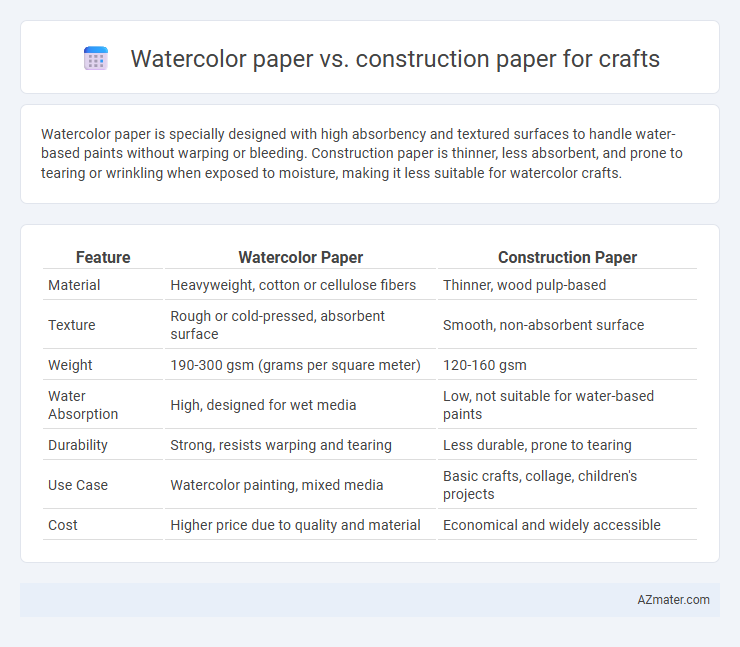Watercolor paper is specially designed with high absorbency and textured surfaces to handle water-based paints without warping or bleeding. Construction paper is thinner, less absorbent, and prone to tearing or wrinkling when exposed to moisture, making it less suitable for watercolor crafts.
Table of Comparison
| Feature | Watercolor Paper | Construction Paper |
|---|---|---|
| Material | Heavyweight, cotton or cellulose fibers | Thinner, wood pulp-based |
| Texture | Rough or cold-pressed, absorbent surface | Smooth, non-absorbent surface |
| Weight | 190-300 gsm (grams per square meter) | 120-160 gsm |
| Water Absorption | High, designed for wet media | Low, not suitable for water-based paints |
| Durability | Strong, resists warping and tearing | Less durable, prone to tearing |
| Use Case | Watercolor painting, mixed media | Basic crafts, collage, children's projects |
| Cost | Higher price due to quality and material | Economical and widely accessible |
Key Differences Between Watercolor Paper and Construction Paper
Watercolor paper features a textured, thick surface designed to absorb and hold watercolor pigments without warping or tearing, making it ideal for painting techniques requiring water application. Construction paper is thinner, less durable, and often has a smoother finish, intended primarily for cutting, folding, and dry media crafts like crayons or markers. The key differences lie in weight, absorbency, and texture, with watercolor paper supporting wet mediums and construction paper best suited for dry, simple craft projects.
Material Composition and Texture Comparison
Watercolor paper is composed of high-quality cellulose fibers, often cotton or wood pulp, designed to absorb and hold water without warping, featuring a textured surface called cold-press or rough finish that enhances paint adherence. Construction paper consists of lower-grade wood pulp with less durability and a smoother, less absorbent texture that can buckle or tear when wet, making it less suitable for water-based crafts. The dense, absorbent texture of watercolor paper supports vibrant, controlled paint application, while construction paper is ideal for dry media and basic cutting or folding crafts.
Absorbency and Water Resistance
Watercolor paper offers superior absorbency, allowing it to hold and distribute water evenly without warping or tearing, making it ideal for wet media and detailed washes. In contrast, construction paper has low absorbency and tends to warp or buckle when exposed to moisture, limiting its use in water-based crafts. Its poor water resistance causes colors to bleed and the paper to weaken quickly, whereas watercolor paper maintains structural integrity and vibrant color retention under wet conditions.
Durability for Different Art Projects
Watercolor paper offers superior durability due to its thick, textured surface designed to absorb water without warping, making it ideal for wet media and detailed painting projects. Construction paper, while affordable and easy to cut, lacks the strength and water resistance required for wet techniques, often resulting in buckling and tearing during use. For mixed-media or heavy layering crafts requiring longevity, watercolor paper provides a more robust foundation to withstand repeated handling and moisture exposure.
Suitability for Watercolor Painting
Watercolor paper is specially designed to absorb and hold water without warping, making it ideal for watercolor painting due to its texture and weight, typically ranging from 140 lb (300 gsm) upwards. Construction paper, often thinner and less durable, tends to buckle and deteriorate when wet, which limits its suitability for watercolor projects. Artists seeking precision and color vibrancy prefer watercolor paper for its ability to handle multiple washes and preserve pigment quality.
Color Vibrancy and Paint Performance
Watercolor paper offers superior color vibrancy and paint performance due to its textured, absorbent surface that allows watercolor paints to spread evenly and retain rich pigments. Construction paper, being less absorbent and smoother, tends to dull colors and can cause paint to bead or warp the paper, resulting in less vivid artwork. For vibrant, high-quality watercolor crafts, choosing heavy-weight, acid-free watercolor paper ensures optimal paint flow and color brilliance.
Cost and Accessibility
Watercolor paper typically costs more due to its thicker texture and specialized composition designed to hold water and pigment without warping, making it ideal for detailed painting projects. Construction paper is more affordable and widely accessible, available in most craft and school supply stores, making it suitable for general crafting activities and projects requiring vibrant colors. Budget-conscious crafters often choose construction paper for its cost-effectiveness and availability, while artists working with water-based media prefer the durability and quality of watercolor paper.
Environmental Impact and Sustainability
Watercolor paper often uses higher-quality, acid-free fibers and can be sourced from sustainably managed forests, making it more environmentally friendly compared to construction paper, which typically contains recycled materials but may have lower durability and higher chemical additives. Construction paper tends to decompose more quickly due to its lower-density fibers and chemical treatments, negatively impacting sustainability when discarded in landfills. Choosing recyclable, FSC-certified watercolor paper supports long-term environmental conservation while minimizing waste and chemical pollution in craft projects.
Best Uses for Watercolor Paper in Crafts
Watercolor paper excels in crafts that involve wet media due to its thick, textured surface designed to absorb and hold water without warping. Its heavyweight composition supports layering and blending of watercolor paints, making it ideal for detailed artwork, mixed media projects, and card making. In contrast to construction paper, watercolor paper ensures durability and color vibrancy, essential for high-quality, professional-looking craft creations.
Ideal Craft Projects for Construction Paper
Construction paper is ideal for craft projects that require bold colors and easy manipulation, such as cut-out shapes, collages, and layered designs, due to its sturdy texture and wide color range. It excels in children's crafts, paper mache, and simple card-making where flexibility and thickness are beneficial without the need for water resistance. Unlike watercolor paper, which is best suited for painting with water-based mediums due to its absorbent surface, construction paper is preferred for dry media and paper crafting tasks.

Infographic: Watercolor paper vs Construction paper for Craft
 azmater.com
azmater.com